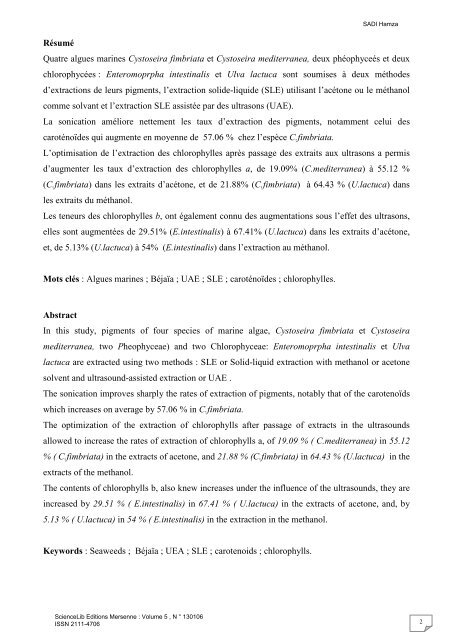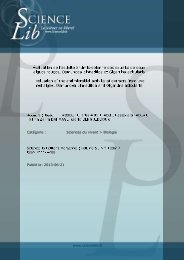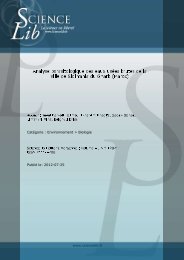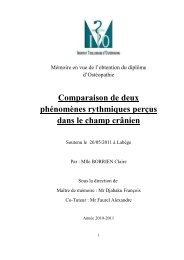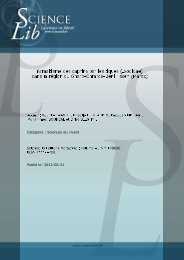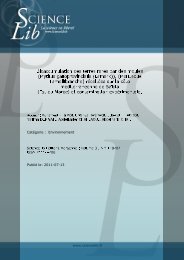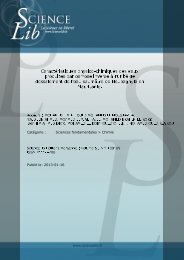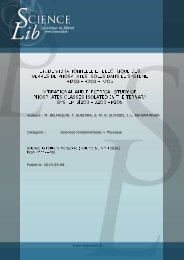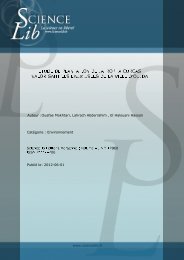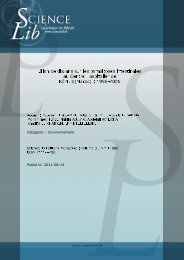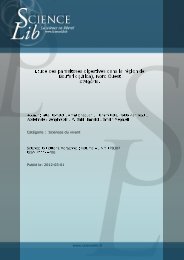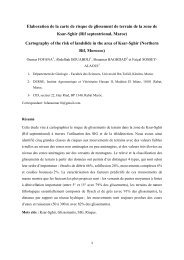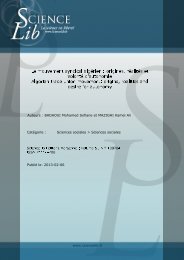Effet de la sonication sur les rendements d'extraction ... - Sciencelib
Effet de la sonication sur les rendements d'extraction ... - Sciencelib
Effet de la sonication sur les rendements d'extraction ... - Sciencelib
Create successful ePaper yourself
Turn your PDF publications into a flip-book with our unique Google optimized e-Paper software.
Résumé<br />
Quatre algues marines Cystoseira fimbriata et Cystoseira mediterranea, <strong>de</strong>ux phéophyceés et <strong>de</strong>ux<br />
chlorophycées : Enteromoprpha intestinalis et Ulva <strong>la</strong>ctuca sont soumises à <strong>de</strong>ux métho<strong>de</strong>s<br />
d’extractions <strong>de</strong> leurs pigments, l’extraction soli<strong>de</strong>-liqui<strong>de</strong> (SLE) utilisant l’acétone ou le méthanol<br />
comme solvant et l’extraction SLE assistée par <strong>de</strong>s ultrasons (UAE).<br />
La <strong>sonication</strong> améliore nettement <strong>les</strong> taux d’extraction <strong>de</strong>s pigments, notamment celui <strong>de</strong>s<br />
caroténoï<strong>de</strong>s qui augmente en moyenne <strong>de</strong> 57.06 % chez l’espèce C.fimbriata.<br />
L’optimisation <strong>de</strong> l’extraction <strong>de</strong>s chlorophyl<strong>les</strong> après passage <strong>de</strong>s extraits aux ultrasons a permis<br />
d’augmenter <strong>les</strong> taux d’extraction <strong>de</strong>s chlorophyl<strong>les</strong> a, <strong>de</strong> 19.09% (C.mediterranea) à 55.12 %<br />
(C.fimbriata) dans <strong>les</strong> extraits d’acétone, et <strong>de</strong> 21.88% (C.fimbriata) à 64.43 % (U.<strong>la</strong>ctuca) dans<br />
<strong>les</strong> extraits du méthanol.<br />
Les teneurs <strong>de</strong>s chlorophyl<strong>les</strong> b, ont également connu <strong>de</strong>s augmentations sous l’effet <strong>de</strong>s ultrasons,<br />
el<strong>les</strong> sont augmentées <strong>de</strong> 29.51% (E.intestinalis) à 67.41% (U.<strong>la</strong>ctuca) dans <strong>les</strong> extraits d’acétone,<br />
et, <strong>de</strong> 5.13% (U.<strong>la</strong>ctuca) à 54% (E.intestinalis) dans l’extraction au méthanol.<br />
Mots clés : Algues marines ; Béjaïa ; UAE ; SLE ; caroténoï<strong>de</strong>s ; chlorophyl<strong>les</strong>.<br />
Abstract<br />
In this study, pigments of four species of marine algae, Cystoseira fimbriata et Cystoseira<br />
mediterranea, two Pheophyceae) and two Chlorophyceae: Enteromoprpha intestinalis et Ulva<br />
<strong>la</strong>ctuca are extracted using two methods : SLE or Solid-liquid extraction with methanol or acetone<br />
solvent and ultrasound-assisted extraction or UAE .<br />
The <strong>sonication</strong> improves sharply the rates of extraction of pigments, notably that of the carotenoïds<br />
which increases on average by 57.06 % in C.fimbriata.<br />
The optimization of the extraction of chlorophylls after passage of extracts in the ultrasounds<br />
allowed to increase the rates of extraction of chlorophylls a, of 19.09 % ( C.mediterranea) in 55.12<br />
% ( C.fimbriata) in the extracts of acetone, and 21.88 % (C.fimbriata) in 64.43 % (U.<strong>la</strong>ctuca) in the<br />
extracts of the methanol.<br />
The contents of chlorophylls b, also knew increases un<strong>de</strong>r the influence of the ultrasounds, they are<br />
increased by 29.51 % ( E.intestinalis) in 67.41 % ( U.<strong>la</strong>ctuca) in the extracts of acetone, and, by<br />
5.13 % ( U.<strong>la</strong>ctuca) in 54 % ( E.intestinalis) in the extraction in the methanol.<br />
Keywords : Seaweeds ; Béjaïa ; UEA ; SLE ; carotenoids ; chlorophylls.<br />
ScienceLib Editions Mersenne : Volume 5 , N ° 130106<br />
ISSN 2111-4706<br />
SADI Hamza<br />
2


